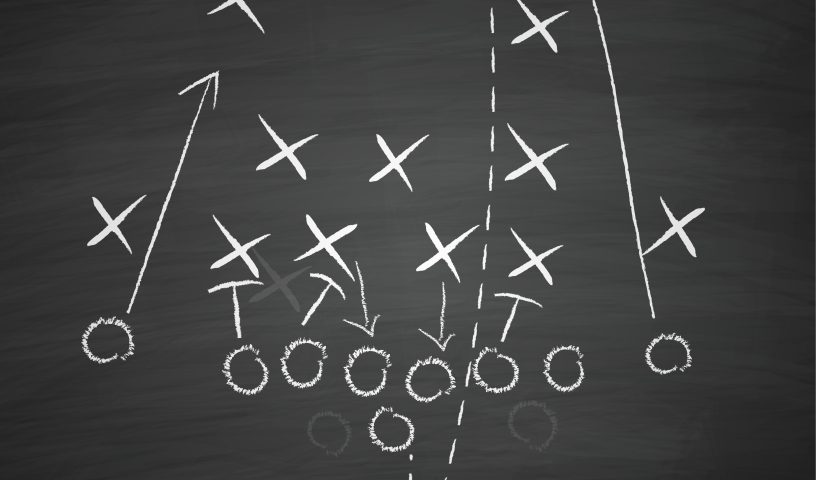
By: Rick Pollick
Originally posted on Medium.com
What can Football teach us about agile frameworks & high-performing teams?
— WRITTEN AS A SPEECH OUTLINE —
Pre-Game:
- Do you know what the greatest professional football dynasties (1970s Steelers, 1990s San Francisco, and 2000s NE Patriots) all have in common? They were high-performing agile teams using the “football framework”.
- Every week the world watches one of the most useful examples of how to cut through the “noise” of agile methodologies.
- When you distill a project down; you find that is very similar to the game of football. — Objectives, measurements, milestones, hardships, changes, and goals. — One may also hear similar/interchangeable terminology…
- Teams… especially agile teams, also look similar to a football team. — The planners, the leads, the playmakers, and those who work to make it come together.
- Any team can be: “Mobile, agile, hostile!” like the famous T.C. Williams Titans Football Team — by thinking like a football player!
First Down: The most popular agile activity in the world: Football
{This segment will consist of a general background of football and a juxtaposition of the construct/players involved in both football & an agile team.}
The Basics:
- Football game (similar to a project)
- Football team possession (similar to a sprint)
- Milestones & Measurements (downs)
- Plans (plays)
- Goals are scored
The Players:
- The Front Office = The Organization
- The Coaching Staff = The Product Team/Management
- The people who define plans/plays and their expected outcome
- The Quarterback = Team Lead(s)
- The Running back = The hardworking colleagues who can “plow” through impediments
- The Receivers = Skilled positional team members who help accelerate a project or goal
- (On Defense) The linebackers, corner backs, safeties = The Quality Assurance team… ensuring that nothing negatively impacts the progress of the team
- The Offensive/Defensive Line = The key support team members
- This is a most interesting & typically underappreciated part of a team. These are the team members who understand the plan/play, know what the other positional players are going to do, and make it possible for the play to develop through “moving” impediments and protecting the team.
The Fundamentals:
- While an exact 1:1 comparison cannot be made for each position on a football field, there are distinct similarities between the gridiron and an agile team.
- We see that teams (both football & agile) are formed, primarily through “drafting” the players that they think can help them achieve their goals.
- Plans (or plays) are drawn up, with a certain expectation of success
- Those players work together, in unique ways, every time the ball is snapped to help them achieve those goals.
- Teams typically have players with specialized skillsets, which allow them to build the trust of their teammates each time they execute a task.
- Sometimes the unexpected happens… and plans/plays break-down. Teams need to know what their options are to mitigate risk or loss.
Second Down: How do teams identify what to do, when to do it & who should do it?
- In football, during the course of a game, progress towards a goal is measured in a series of four “downs” at a time. If a team can move the football (without issue) 10 yards during those four downs, it gets a first down and continues to move toward a goal!
- If a football team cannot make a first down, they must decide whether to punt the ball away, kick a field goal, or go all-in on the final down.
- Similarly, to the downs in football, teams work (or sometimes “sprint”) toward milestones en route to a goal. At a basic level, the more goals a team achieves guarantees sustained project success. But sometimes things come up & plays break down.
- Just as in football, it is important that teams know what to do in a given situation and when to consider the following:
- What are the fallback plans is a play/plan breaks-down?
- When is it appropriate to either get some of the “points”, or meet some of the goal (like a field goal), or punt to gain a new perspective?
- In what scenarios should a team go all-in and “gamble” on getting something to the next milestone?
Third Down: Put it into practice!
- Start thinking like a football team!
- Huddle up before possessions or plays
- Hold a daily scrum session & open lanes of communication
- Football coaching staffs are notorious for their pep-talks, but between football games… they meticulously review film, analytics, metrics, and feedback to see where a team can improve. — This is exactly what a team should do! Some examples include:
- Hold a retrospective after each “game” & review useful team metrics
- The presentation will review an example of a useful retrospective activity (the football themed retro)
- Make sure that discussions and retrospectives yield action items for the team to continue to improve.
- Cultivate a team atmosphere. It is imperative that a team understands each of their roles, learns from each other & trusts each other. A team should understand that they are all working toward a common goal together.
- Beyond routine execution of a play/plan, cross-team training & bonding is invaluable to creating this atmosphere.
- Furthermore, team members will start to understand who can help or fill-in when difficulties arise.
- Determine team options when a play/plan breaks-down — how will a team respond to adversity?
- Design project plans, like plays, to have the ability to “check-down” or “hand-off” when needed — to ensure a team can get to that next first down
- Hold effective planning sessions which design “plays” that utilize the strengths of your team.
- For example: if a football team is better at passing the football that running it, they would design plays to emphasize that aspect of their game.
- An agile team should design project plans and backlogs, which take into account how their team operates best.
Fourth Down: Tying the football mindset together
- Of all of the thousands of books, literature, and discussions around agile frameworks, teams, and various approaches — it is useful to simply look toward the good ‘ol gridiron.
- Adversity is part of the game, but it is how creatively a team can work together to both learn & overcome adversity and score.
- Sometimes, a team must win by attrition, but the key is how you execute, plan, and grow as a team.
- This thought process DOES NOT negate the use of a various agile methodologies (i.e. SAFe, XP, traditional Scrum, Kanban, etc.) — rather it is a team-oriented mindset which can be used to cut through “noise”.
Reiterated: When you distill a project down; you find that is very similar to the game of football. — Objectives, measurements, milestones, hardships, changes, and goals.
Reiterated: Teams… especially agile teams, also look similar to a football team. — The planners, the leads, the playmakers, and those who work to make it come together.
Touchdown:
- All should remember the now famous line from Remember the Titans. Teams should be: “Mobile, agile, hostile!”
- It is not important to do everything by-the-book, or to follow a specific agile method to the letter, but rather to understand the fundamentals. — After all, this is key when considering the rationale behind the Agile Manifesto.
- There will always be rules as well as organizational policies to adhere to — but a team should align their thinking to reach their goals.
- Football offers insight into a proven “framework” focusing on team coordination, trust, and effective execution.
- To help a team strive to be the G.O.A.T. (Greatest of All Time) they should start to think like a football player & use the “Football Framework”.


